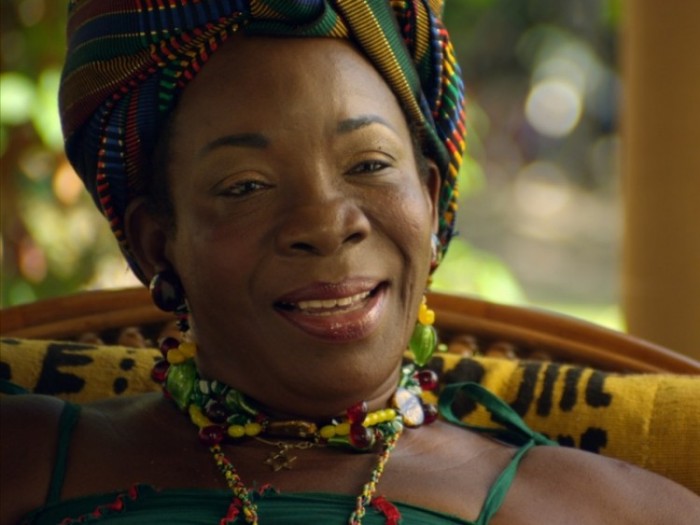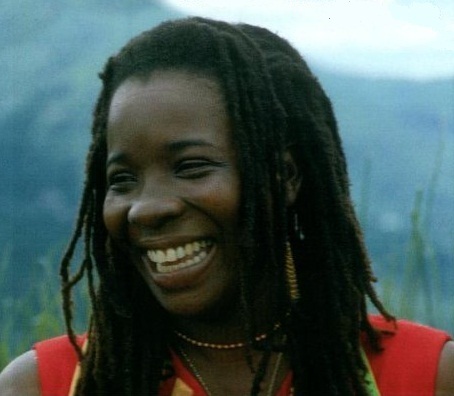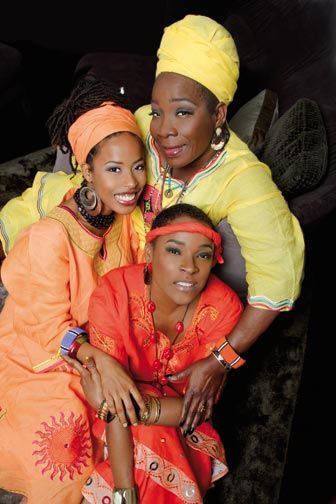Perhaps best known as the widow of reggae legend Bob Marley and often called the “Queen of Reggae,” Rita Marley has spent time and energy as the guardian of her late husband’s estate and musical legacy, and, more important, as the keeper of the flame of his ideas. But her role in the history of Jamaican music has not been limited to her relationship with Bob Marley. In the mostly male-dominated field of reggae, she was a solo act of note before she ever joined with her husband musically, and she emerged as a successful artist on her own after his death. Moreover, as part of Bob Marley’s backing trio of female vocalists, the I-Threes, Rita Marley was an important contributor to the music that made her husband famous worldwide. She has also emerged as an important booster of economic development and self-sufficiency in her adopted home country of Ghana.
Rita Marley was born Alpharita Constantia Anderson in Santiago de Cuba, Cuba, on July 25, 1947 to Leroy Anderson and Cynthia “Beda” Jarrett. Growing up poor, she was abandoned by her mother when she was just 5 years old, Rita and her brother, Wesley, were raised by their father and an aunt Viola in the neighborhood of Trench Town, Kingston, Jamaica. Their mother raised their other brother, Donovan.
When she was just 13, Rita was left in her aunt’s care when her father moved to England to look for work (he reportedly told her that she would join him later, but that move never happened). After high school, Rita attended the Bethesda School of Practical Nursing, but an unexpected pregnancy derailed her education. She had her first child, a daughter named Sharon, in 1964.
Kingston, Jamaica has spawned the careers of many of the musicians who created a rhythmically complex, spiritually inclined new music called reggae. Three of those musicians, who had formed a trio called the Wailers, often passed by the metal shack where Rita was living with her aunt and small child. The Wailers consisted of Bob Marley, Peter McIntosh (later Peter Tosh) and Bunny Livingston (later Bunny Wailer); they were among the first acts to record at the influential studio of producer Clement “Coxsone” Dodd, who ran the Studio One record label. Bob Marley, already a standout talent, made a special impact. “I remember how I would scream to hear his songs on the radio,” Rita Marley told Interview.
An aspiring singer herself, Rita asked the group to set up an audition with Dodd for her. The eighteen-year-old singer succeeded at the audition and was joined with her cousin, Constantine “Dream” Walker, and friend, Marlene “Precious” Gifford; the trio became known as the Soulettes, with Bob Marley as their producer. The Soulettes scored several hits under Bob’s leadership, and had a hit with the song I Love You, Baby, and sometimes sang backup on some of the Wailers’ early recordings. Rita also had a few solo hits of her own, most notably Pied Piper.
What was at first a purely professional relationship between Rita and Bob took a new turn one day when Bunny Wailer gave Rita a handwritten love note from Bob. The two married in 1966. They welcomed their first child together, daughter Cedella, in 1967. The following year, the couple had their first son, David, who is now best known as Ziggy Marley. Rita and Bob struggled both financially and professionally. They spent some time in the United States, working for singer Johnny Nash’s JAD Records in the late 1960s and living with Bob’s mother in Wilmington, Delaware, for a time.
In the early 1970s, Rita returned to her mother-in-law’s home in the US, to live and work, hoping to improve her family’s financial situation. Rita had son Ziggy with her at the time, with her daughters staying with her aunt, but she decided to go home to Jamaica after giving birth to son Stephen Marley in 1972. Returning to Jamaica, Rita discovered that Bob had been involved with two different women while she was away, and that both of these women were pregnant; their children, Robert and Rohan Marley, were born not long after Stephen. In her 2004 autobiography, No Woman No Cry: My Life with Bob Marley, Rita Marley wrote: “I was very upset at first to learn about all this, though it’s common in Jamaica. But since then, I’ve come to love both of these boys and to think of them as my sons.” She would maintain this generous attitude toward the many other children Bob would father with other women over the years.
After the Wailers signed with Island Records in 1972, things began to turn around for the band members, but not necessarily for the Marleys. The group had their first album with the label, Catch a Fire, released internationally the next year, and they began to attract critical attention. With their popularity on the rise, the Wailers toured the United States and Europe.
Not all was well, however. Rita’s marriage was under a lot of stress: In addition to Bob often being away and seeing other women, Rita herself had embarked upon an extramarital affair before giving birth to her fourth child, daughter Stephanie, in 1974. However, she stated in her autobiography that Bob was the father.
Rita Marley influenced her husband in what became the central spiritual tenet of his music—the Jamaican variant of Christianity known as Rastafarianism. It was she who turned out for a personal appearance by Ethiopian emperor Haile Selassie—thought by Rastafarians to be the returned Jesus Christ—and noticed marks on his hands that she believed were the nail scars left by Christ’s crucifixion. Rita converted to Rastafarianism and induced her husband to do the same. One of the recordings that would really launch his fame as a solo artist and bandleader in the early 1970s was Jah Live, an anthem written after Selassie’s death.
For that record, Bob Marley assembled another backing trio, dubbed the I-Threes, consisting of Rita Marley, Judy Mowatt, and Marcia Griffiths — all of whom would go on to important solo careers. The I-Threes evolved into a fundamental component of the reconstituted Bob Marley and the Wailers, which over the course of the 1970s forged an internationally popular music that featured a language of its own that expressed Rastafarian concepts; a distinctive look featuring the twined strands of hair known as dreadlocks; and a political side that looked to the eventual overthrow of the white elites who ruled the peoples of the African diaspora.
With Bob Marley and the Wailers, Rita Marley and the I-Threes toured the world, appearing as far afield as newly independent Zimbabwe. In 1976 the Marleys became victims of Jamaica’s notoriously violent political culture; they were shot in their home by gunmen two days before performing a benefit concert for a socialist-oriented political party. Wounded, both still performed—Rita in her hospital gown. The I-Threes also appeared on their own, and Rita Marley was making plans to release a solo album when Bob Marley died of brain cancer in 1981, at the age of thirty-six.
After her husband’s death, Rita went ahead with plans to release the album, Who Feels It Knows It. Far from being a funeral dirge lamenting Bob’s death, the album showcased Rita’s musical personality. It contained a comic piece about marijuana, One Draw, which was banned by radio stations due to a passage in which a schoolteacher instructs her students in the enjoyment of the drug. The controversy fueled sales of the album, and Rita went on to record two more successful albums in the 1980s, released in the United States on the roots-oriented Shanachie label. The 1990 album We Must Carry On, which included several previously unknown Bob Marley compositions, was nominated for a Grammy Award. She also contributed backup vocals to albums by other artists ranging from West African reggae star Alpha Blondy to Haitian-American rapper Wyclef Jean.
Much of Rita’s energy in the 1980s, however, was devoted to the care of her husband’s legacy in various ways. Bob Marley died without a will, and associates from several phases of his career came out of the woodwork to contest the Marley family’s rights to his estate, valued in the tens of millions of dollars. The resulting litigation went all the way to the Jamaican Supreme Court, which ruled in Rita Marley’s favor in 1991.
Rita had 6 children: Sharon, Cedella, David (Ziggy), Stephen, Stephanie, and Serita; and also cared for her husband’s other ten children, several of which he had fathered with other women. She is the chairperson of Bob Marley Foundation, a charitable organization dedicated to helping people fight poverty and hunger in developing countries, and curator of Bob Marley Museum, Kingston, Jamaica. Rita also works to preserve Bob’s music and memory through numerous events, including the annual Bob Marley Birthday Celebration in Jamaica.
Rita Marley has also continued to pursue her solo career, releasing albums such as Sunshine After Rain (2003) and Play Play (2004), and performing live. In recent years, she joined Marcia Griffiths and Judy Mowatt of the I Threes to perform at the Africa Unite concert in Addis Ababa, Ethiopia. She produced several albums by her son Ziggy Marley and her other children and other artists; and is involved in operations of Marley family-owned Tuff Gong record label.
In 1998 Rita established the Rita Marley Foundation as a sister organization of the Bob Marley Foundation. Both foundations served as the bases for Marley’s work to help residents of impoverished areas become more self-sufficient. A few years later Rita moved to Ghana, where she both lives and runs her foundation, as well as a studio outpost of the Marley family’s Jamaica-based Tuff Gong empire of recording and production operations. There, through her foundation, she has distributed vaccinations, furnished schools, helped develop community agricultural projects, and delivered needed household goods to remote villages. Meanwhile, she has continued to record and tour extensively, releasing several albums during the first decade of the twenty-first century, and producing albums for other musicians, mostly her own children. In 2004 Marley published a memoir, co-written with Hettie Jones, called No Woman No Cry: My Life with Bob Marley. The book recounted in wrenching detail the story of their relationship, from the streets of Trench Town to the heights of international stardom.
In 2008 two different movie projects focusing on the life of Bob Marley were launched. Early in the year acclaimed director Martin Scorsese announced plans to make a documentary about Marley, to be coproduced by Tuff Gong, with Rita’s blessing. Just a couple months later producer Harvey Weinstein announced that he would produce a film version of Rita Marley’s book, No Woman No Cry, with Marley as executive producer. Marley expressed her hope that she would be played by award-winning singer/rapper Lauryn Hill in the movie adaptation. The appearance so close together of two competing movies sparked conflict over the rights to use Bob Marley’s music, which the Marley family had historically refused to license. Initially, the family refused to license the music to Weinstein, even though Rita was named as an executive producer on the project. The problem was that the family had already granted rights to Scorsese, and they saw the Weinstein film, which was likely to hit the theaters around the same time, as a threat to the Scorsese documentary, in which they were already invested. In May of 2008 Scorsese withdrew from the Marley project and was replaced by fellow award-winning director Jonathan Demme. As of late 2008 neither the Weinstein movie nor the Demme documentary had progressed significantly.
Regardless of what Rita accomplishes during her life, in either the musical or philanthropic realm, her name will always be most closely tied to the work of her late husband, who she concedes had a profound influence in making her the person she has become. Rita is head of the Bob Marley Foundation in Kingston, which operates a museum devoted to the singer’s life and work. “He was a good boy, still is, and that’s why we have to carry on his mission,” Marley explained to the Guardian of her work with the foundation. “He was a father figure for me,” she continued. “He saved me from being somebody else. I could have been prime minister, I could have been a prostitute on the streets, but I am what I am and Bob has a lot to do with that.”
On 3 August 2013, Rita Marley was made an honorary citizen of Ghana by the Ghanaian government.
Sources:
http://www.encyclopedia.com/topic/Rita_Marley.aspx
http://www.biography.com/people/rita-marley-297418
https://en.wikipedia.org/wiki/Rita_Marley











